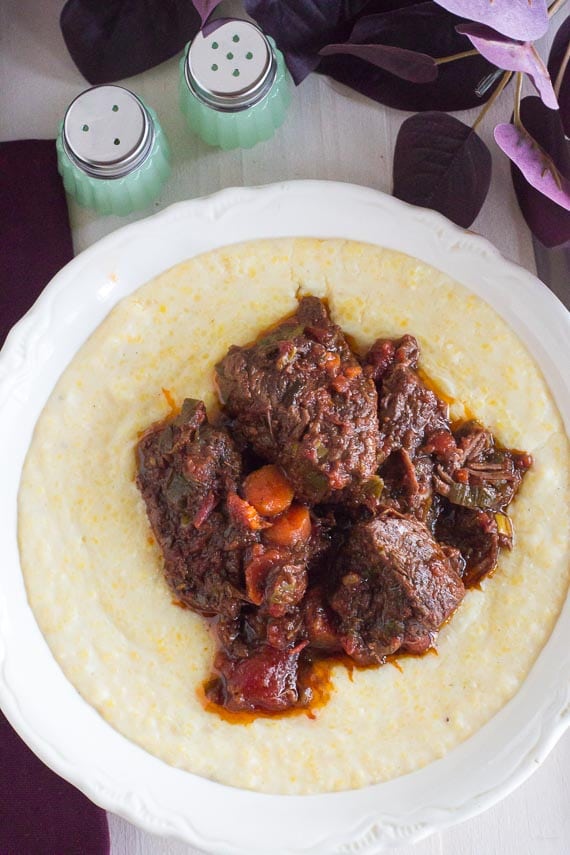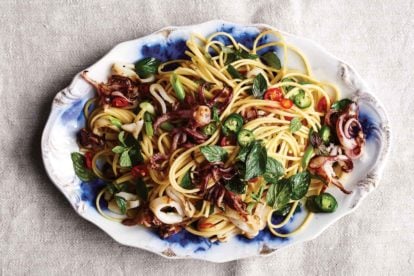Easy Slow Cooker Low FODMAP Short Ribs with Rosemary & Orange
Get your slow cooker ready for our Low FODMAP Short Ribs! When the weather turns cooler we start thinking of heartier dishes like casseroles and braises. The slow cooker, sometimes referred to as the original brand name, “Crock Pot”, is the perfect device to help you with these tasks – so that they do not feel like tasks at all!
This IBS-friendly recipe for Slow Cooker Low FODMAP Short Ribs with Rosemary & Orange is super delicious and thanks to the slow cooker, super easy.
The rosemary adds savory depth, while the orange zest adds brightness. Red wine and both whole, peeled tomatoes and tomato sauce provide substance, acidity and flavor.
Short Ribs LOVE a Long Cooking Time
Short ribs are a fatty cut of beef that transform when exposed to long, slow cooking times. The collagen breaks down and the texture becomes fall-apart tender. So tender in fact that you can break this meat up with a fork and use it as a ragu for pasta or polenta ( or cheesy grits). You might be tempted to fill a bowl and eat with a spoon – and who are we to say no to that kind of comfort food experience? Go for it!
Convenience at Every Turn
Not only will the slow cooker do the work for you, but you can also choose which cooking temperature and time is most convenient for you – a shorter 6 hours on High or 8 hours on Low.
If you are a short ribs fan, also check out our Short Ribs with Horseradish & Red Wine.

Low FODMAP Slow Cooker Short Ribs with Rosemary & Orange
These Low FODMAP Slow Cooker Short Ribs with Rosemary & Orange are easy to make, yet special enough for guests.
Ingredients:
- 2 cups (480 ml) Quick Tomato Sauce, or equivalent of jarred low FODMAP marinara style sauce
- 1, 14- ounce (411 g) can peeled tomatoes in juice
- 2 tablespoons Garlic-Infused Oil, made with olive oil, divided
- 1 cup (72 g) finely chopped leeks greens
- 1 cup (64 g) finely chopped scallion greens
- 1 medium carrot, trimmed, peeled and cut crosswise into 1/2-inch (12 mm) rounds
- 3 pounds (1.4 kg) boneless short ribs, cut into 3-inch to 4-inch (7.5 cm to 10 cm) pieces
- Kosher salt
- Freshly ground black pepper
- 2 tablespoons dry red wine
- 2 teaspoons fine orange zest, made with a Microplane zester
- 1 teaspoon dried rosemary
Preparation:
-
Pour the tomato sauce into a large slow cooker. Pour in the peeled tomatoes and all their juice, breaking up the tomatoes with a wooden spoon.
-
Heat a large sauté pan over low heat, add 1 tablespoon of the oil and heat until shimmering. Add the leek greens, scallion greens and carrots and sauté for a few minutes or until the leeks and scallions soften, then scrape into slow cooker.
-
Season the short ribs with salt and pepper. Replace the sauté pan on stove over medium heat, add remaining oil and brown the short ribs, in batches, on two sides. After they are browned, transfer to the slow cooker, nestling down in the tomato sauce. When the last short ribs have been moved out of the pan, deglaze the pan with red wine, scraping up any browned bits and scrape everything into the slow cooker. Add orange zest and rosemary to slow cooker, give everything a good stir to combine and cover.
-
Set slow cooker on High for 6 hours (or Low for 8 hours). Skim off any fat that has risen to the surface. Serve with low FODMAP pasta or polenta. These Slow Cooker Italian Short Ribs with Rosemary & Orange can be refrigerated in an airtight container for up to 5 days or frozen for up to 1 month. Defrost as needed in refrigerator overnight. Reheat on the stove over low heat.
-
Place a low FODMAP amount of cooked pasta or polenta on a plate, top with short ribs and sauce and serve.
Notes:
Tips
- You can use our very own recipe for Quick Tomato Sauce, or you can purchase a low FODMAP Marinara Sauce. Just make sure to read labels for high FODMAP ingredients.
Nutrition
All nutritional information is based on third-party calculations and should be considered estimates. Actual nutritional content will vary with brands used, measuring methods, portion sizes and more. For a more detailed explanation, please read our article Understanding The Nutrition Panel Within Our Recipes.
Low FODMAP Recipes Created Just For You!
We take low FODMAP recipes seriously at FODMAP Everyday®. That’s why Dédé oversees our Test Kitchen and makes sure that each and every recipe works – and is low FODMAP following the most up-to-date science.
Read our article How Are Low FODMAP Recipes Created? for more in-depth information.
Rest assured that you will not find more trustworthy or delicious low FODMAP recipes anywhere – several hundred and counting.
FODMAP Everyday®Low FODMAP Recipes At A Glance:
- FODMAP Everyday®is accredited by FODMAP Friendly.
- Dédé is low FODMAP trained by Monash University.
- Dédé is also individual accredited as a recipe developer and FODMAP educator by FODMAP Friendly.
- We maintain our own professional Test Kitchen.
- Dédé has over 30 years of professional recipe development experience, including her stint as a Contributing Editor for Bon Appetit magazine and has written 17 cookbooks.
Come Join Our Low FODMAP Recipe Community!
Use Our Exclusive Recipe Filter To Find The Low FODMAP Recipe You Are Looking For Today!











